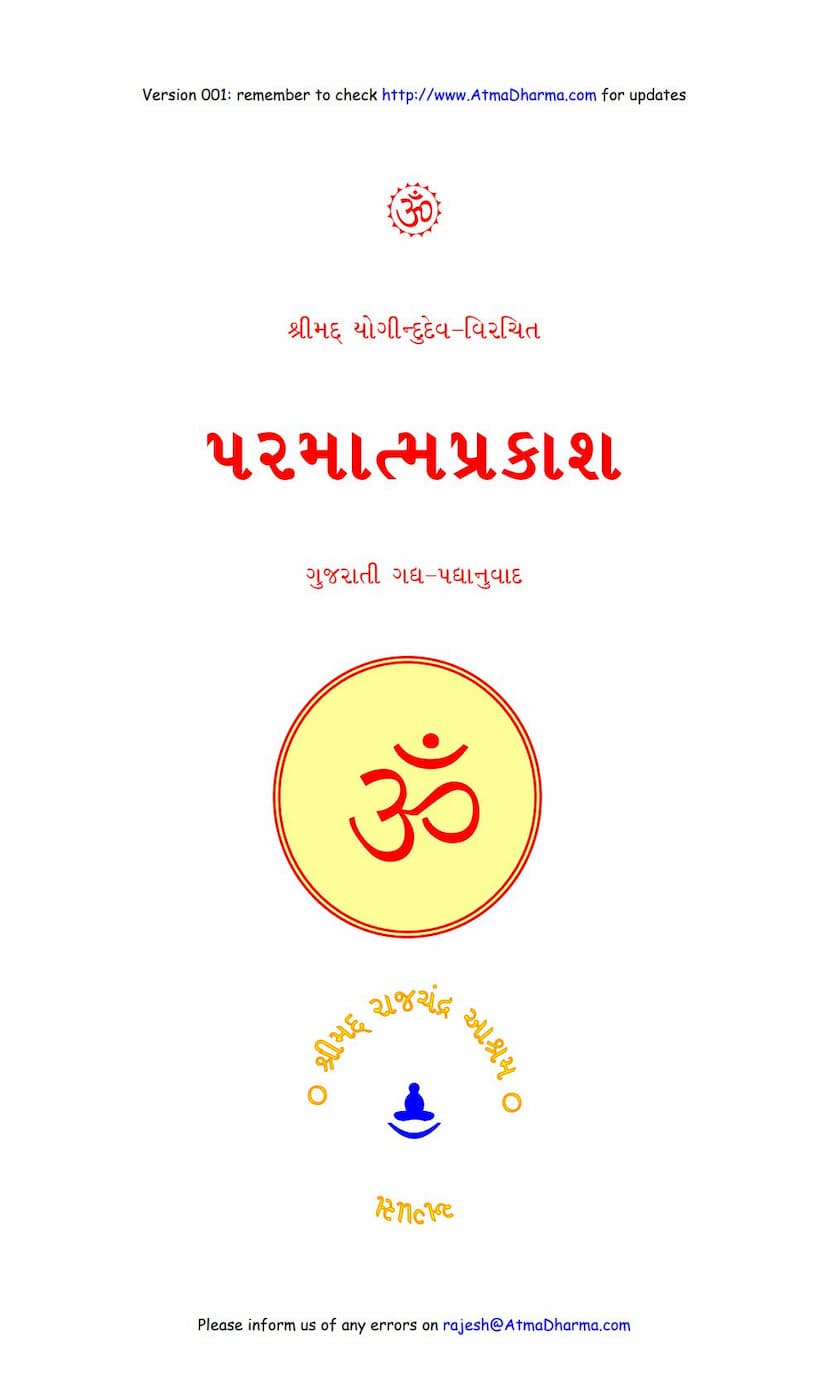Parmatma Prakash
Added to library: September 2, 2025

Summary
This is a comprehensive summary of the Jain text "Parmatma Prakash" (Paramatma Prakash) by Yogindudev, translated by Ravjibhai C Desai and Pandit Gunbhadra Jain, published by Shrimad Rajchandra Ashram. The text is a Gujarati translation of the original work.
The provided text is the preface and the beginning chapters of the book, outlining its purpose, genesis, and introductory philosophical concepts.
Here's a breakdown of the summary:
1. Book Details and Acknowledgements:
- Title: Parmatma Prakash (પરમાત્મપ્રકાશ)
- Author: Yogindudev (શ્રીમદ્ યોગીન્દુદેવ)
- Translators: Ravjibhai C Desai (Gujarati prose and poetry translation), Pandit Gunbhadra Jain (Gujarati prose translation).
- Publisher: Shrimad Rajchandra Ashram, Agas, Gujarat.
- Donation: The electronic version was made available through the generosity of Kusumben Amritlal Bavisha and Ansuyaben Anupchand Bavisha, in memory of Anupchand Dahyalal Bavisha.
- Request: Readers are asked to report any errors to [email protected] to improve accuracy and to check for updated versions.
2. Core Jain Philosophy and Purpose of the Book:
- Goal: To guide seekers ("mumukshu") towards self-realization and the ultimate goal of liberation (Moksha).
- Central Theme: The book emphasizes the importance of self-inquiry ("Atma Vichar") and self-knowledge ("Atma Gnana") as the unique path to freedom from suffering and attainment of eternal happiness.
- The Nature of True Happiness: True happiness is not found in worldly pleasures, which are fleeting and ultimately lead to suffering. True happiness resides within the soul.
- The Soul (Atma): The text describes the soul as the true, eternal, and pure self, distinct from the physical body and all external phenomena. It is inherently pure, blissful, and possesses infinite knowledge and power, which are obscured by karma.
- The Path to Liberation (Moksha): The path to liberation involves understanding the true nature of the soul, detaching from worldly possessions and relationships, and engaging in spiritual contemplation and practice.
- The Role of the Soul in Jainism: The book reiterates fundamental Jain concepts like the soul's inherent purity, the impermanence of the material world, and the causal link between actions (karma) and their consequences.
3. Key Concepts and Teachings:
- Three Types of Souls (Trividha Atma):
- Bahiratama (Outer Soul): One who identifies the body and external objects as the self.
- Antaratma (Inner Soul): One who recognizes the soul as distinct from external objects and believes in its true nature.
- Paramatma (Supreme Soul): The soul in its completely pure, omniscient, omnipotent, and blissful state, free from all karma and worldly existence.
- Nayas (Perspectives): The text highlights the importance of understanding different "nayas" (perspectives) to comprehend Jain philosophy.
- Nischaya Naya (Absolute Truth): This perspective focuses on the soul's inherent pure nature, unconditioned by karma.
- Vyavahar Naya (Conventional Truth): This perspective explains the soul's journey through the cycle of birth and death due to karma, and the practical steps towards liberation. Both are essential for a complete understanding.
- The "Parmatma Prakash" as a Guide: The book is presented as an invaluable guide that illuminates the path to becoming "Parmatma" (Supreme Soul).
- The Importance of a Guru: The text implicitly emphasizes the role of a qualified spiritual teacher ("Guru") in understanding the subtleties of scripture and achieving self-realization, as exemplified by the dialogue format initiated by Prabhas Bhatt.
- Karma: The text touches upon the concept of karma, explaining how actions bind the soul and lead to suffering, and how liberation comes from shedding these karmic bonds.
- The Nature of the Soul's Attributes: The soul is described as being beyond the limitations of physical attributes like color, smell, taste, touch, sound, birth, death, and even physical form. It is pure consciousness, eternal, and untouched by worldly afflictions.
- The Six Substances (Shad Dravya): The text mentions the six fundamental substances in Jainism (Jiva, Pudgala, Dharma, Adharma, Akasha, Kala) and their attributes, emphasizing the soul's distinctness from the non-soul substances.
- The Path of Practice: The book stresses the necessity of detachment, equanimity (samata), self-control (samyama), and unwavering devotion to the soul's true nature.
- The Importance of Right Faith, Knowledge, and Conduct (Ratnatraya): These are presented as the direct means to achieve liberation.
4. Structure and Content (as gleaned from the table of contents and snippets): The book appears to be structured into two main sections (Adhikaras):
- Prathama Adhikara (First Section): Trividh Atma (Threefold Soul): This section likely details the three types of souls (Bahiratama, Antaratma, Paramatma) and their characteristics.
- Dwitiya Maha Adhikara (Second Section): Moksha Marga Adhikara (Path to Liberation): This section is dedicated to explaining the path to liberation, likely covering topics like the nature of Moksha, the causes of bondage, the means to achieve liberation, and the qualities of a liberated soul.
5. Key Doctrinal Points:
- Detachment from the Body and Worldly Affairs: A central message is the need to transcend attachment to the physical body, family, and worldly possessions, recognizing them as impermanent and ultimately sources of suffering.
- The Illusion of Happiness in Sensory Objects: The book posits that true happiness is not derived from sensory experiences but from the inner realization of the soul's true nature.
- The Power of Self-Inquiry and Meditation: Constant contemplation and meditation on the soul's true nature are presented as the means to purify the mind, overcome karma, and achieve liberation.
- The Goal of Moksha: The ultimate aim is to attain Moksha, a state of eternal bliss, infinite knowledge, and absolute freedom from the cycle of birth and death.
6. The Gujarati Translation: The introduction highlights that the Gujarati translation aims to make this profound spiritual text accessible to a wider audience, preserving the essence of the original teachings while presenting them in an understandable and appealing manner through prose and poetry.
In essence, "Parmatma Prakash" is a profound Jain text that serves as a spiritual guide for aspiring souls seeking liberation by illuminating the path of self-knowledge and detachment, emphasizing the soul's inherent divinity and its potential to transcend the cycle of suffering.